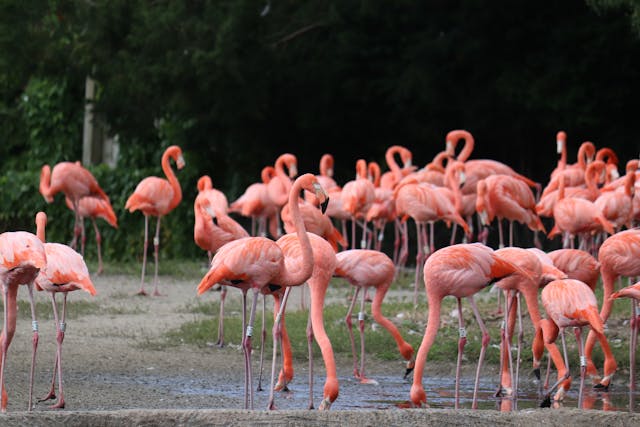
Why are flamingos pink? Flamingos are pink because of all the carotenoids that they eat.
Flamingos are famous for sleeping on one leg while standing up, for eating upside down, and for being a brilliant shade of pink. However, when they are born, they are a slightly off-white color. They take on their pink color because of what they eat, and it is not just their diet of shrimp that is responsible.
There are six species of flamingo around the world, and they vary slightly in size and shade of pink. Some are more red and some are more orange, but they are all pinkish. Flamingos live in very harsh environments. They always live in and around water, but they don’t live in freshwater. Flamingos live in soda lakes, extremely salty lakes, or even on salt flats. These places are very alkaline. A good example is Lake Natron in Tanzania. Roughly 2.5 million flamingos live here, and the water is hypersaline. It is fed by hot springs and the water evaporates very quickly, concentrating the salt, similar to the Dead Sea. The high alkalinity and the high temperature (roughly 60℃) would kill most animals pretty quickly, but flamingos are adapted for it. They have very thick skin on their legs that is covered in scales to protect them. They are also able to drink very hot water, so they can drink out of the lake. The salinity is no problem for them because they have glands under their eyes that remove extra salt from their bodies. Why do flamingos live in these hostile environments? They live there because that is where their food source is.
Flamingos eat blue-green algae and brine shrimp. Brine shrimp are tiny shrimp that are about a centimeter long. They are called brine shrimp because they are able to live in very salty water. Tests have shown that they can survive salinity of even up to 25%. They have evolved this ability because the saltier the water they live in, the safer they are from predators. Flamingos have realized this and have evolved so that they are pretty much the only predator of brine shrimp. Brine shrimp are pink, and some of the flamingo’s pink color does come from the shrimp, but the real reason that both flamingos and brine shrimp are pink is that they also eat blue-green algae.
Blue-green algae are called Cyanobacteria, and they are everywhere on Earth. They are the most numerous living organism on Earth, and they are the first organisms to photosynthesize and start producing oxygen, creating an atmosphere where organisms other than bacteria could thrive. Without them, we probably wouldn’t be here. Blue-green algae contain several pigments so that they can absorb sunlight and photosynthesize. They contain chlorophyll, which is what makes them and plants green. They contain phycobiliprotein, which is similar to chlorophyll. They contain phycoerythrin, which is a red color pigment. They contain phycocyanin, which is a blue color. And they contain carotenoids, which are an orange color pigment, and are the same ones you find in carrots. All cyanobacteria contain these pigments, but they have different amounts of different pigments depending on the environment they live in. Algae that live in very salty conditions, such as the places where flamingos and brine shrimp live, produce far more carotenoids than other algae. And this is the reason why flamingos and brine shrimp are pink. They eat the algae, and the shrimp, and absorb the carotenoids into their blood. Their livers break down the carotenoids into other pigments that are then deposited in the birds feathers and skin, making them pink.
Flamingos use their color as a mating signal as well. They are very pink before mating season and then whiter afterwards. Flamingos look for the pinkest flamingos they can find because the pinker they are the more food they are able to find and the healthier they are. After mating season is over, all of the birds are exhausted and haven’t had time to eat much. They have also given most of their food to their young, which means they have eaten fewer carotenoids and revert back to their original white color. Flamingos in captivity are sometimes white as well because they are fed on different foods than they would eat in the wild, which doesn’t give them the chance to eat carotenoids. And this is what I learned today.
Sources
https://www.earth.com/video/flamingos-live-in-some-of-the-worlds-harshest-places
https://en.wikipedia.org/wiki/Brine_shrimp
https://en.wikipedia.org/wiki/Cyanobacteria
https://www.britannica.com/story/why-are-flamingos-pink
https://thepopularflamingo.com/blogs/posts/the-how-why-of-white-flamingos
https://seaworld.org/animals/all-about/flamingos/adaptations
https://en.wikipedia.org/wiki/Soda_lake
https://en.wikipedia.org/wiki/Flamingo
https://www.sciencefocus.com/nature/why-are-flamingos-pink
https://fppn.biomedcentral.com/articles/10.1186/s43014-023-00155-y
